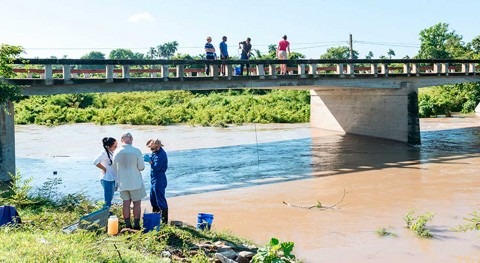The University of Vermont research—which evaluates the benefits of phosphorus reduction on tourism, real estate, and human health around key parts of Lake Champlain—is the first study to calculate the return on investment of Lake Champlain phosphorus cleanup efforts.
Focusing on Missisquoi Bay—a phosphorus hotspot at Lake Champlain’s northeastern end—the study estimates that if phosphorus inputs to the bay are eliminated, it would benefit local tourism by $28.5 million and property sales by $11.2 million between now and 2050.
While the cost of phosphorous cleanup is significant, researchers estimate that the cumulative benefits will begin to outweigh these costs as early as 2057. After that, the net financial and social benefits of clean water and beaches will steadily increase for residents, business, and the State.
The findings, published in the Journal of Environmental Management, help to justify greater phosphorus reduction expenditures, researchers say.

Aerial photo of Lake Champlain cyanobacteria/algae bloom. Credit: University of Vermont Spatial Analysis Laboratory.
Benefits to health and economy
In addition to tourism and real estate benefits, the study also projects a decrease in cases of ALS—also known as Lou Gehrig’s disease—a progressive neurodegenerative disease associated with long-term exposure to phosphorus-driven cyanobacteria blooms.
The projected benefits of cleaning up Missisquoi Bay—which the researchers call “undoubtedly conservative”—hint at the long-term value of phosphorus reduction across the lake. The benefits may be even greater when higher-population lake areas, such as Chittenden County—with higher property values and tourism revenues—are factored in.
“These findings help make the case for greater investment in tackling our phosphorus problem to protect one of Vermont’s most valued environmental amenities—Lake Champlain,” says UVM lead author Jesse Gourevitch. “This study gives decision-makers the first formal cost-benefit analysis of cleaning up the lake, which will bring a suite of benefits to Vermonters.”
Researchers estimate that the cumulative benefits will begin to outweigh these costs as early as 2057
Building on UVM findings on the economic impacts of poor water quality in Lake Champlain, the study uses Vermont EPSCoR’s Integrated Assessment model, which currently only includes Missisquoi Bay data. The team evaluated water quality changes between 2016 and 2050 under a range of phosphorus reduction and climate change scenarios.
The Missisquoi Bay watershed, a rural area with roughly 20,000 Vermonters, accounts for some of Lake Champlain’s highest phosphorus levels. Water quality in the bay is particularly at risk of algal blooms because of its shallow lake bed and phosphorus built up over time in the sediment.
Towards the future
A critical next step is a cost-benefit assessment of cleaning up more parts of the lake. These projections could reveal a shorter return on investment if researchers can show the total benefits of clean water to Vermont—including real estate, tourism and health benefits from other parts of the lake—plus several other factors not in this study: recreational fishing, non-ALS-related health benefits, and many other cultural values that are difficult to quantify.
Noting that cash-strapped farmers often carry the financial burden of phosphorus reduction costs, the researchers suggest: “policies that support farmers’ financial viability” and “examining the cost effectiveness of interventions designed to reduce phosphorus.” One potential solution is the new Vermont Pay-For-Phosphorus pilot program, a partnership between the State of Vermont and UVM, that will pay farmers for phosphorus reductions.
Putting a price tag on nature is challenging, but the researchers say it’s crucial for decision-makers who need to justify these investments.
“How do you put a price on clean water—or the mental health benefits that being out on the lake provides us?” says Gourevitch. “The benefits we calculate are clearly underestimated, and do not capture the diverse values that people have around Lake Champlain,” he says.








